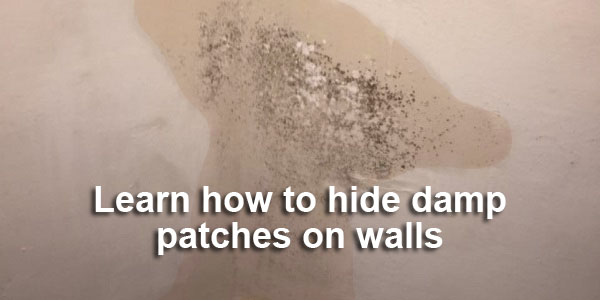The DIY Fix is reader supported. When you buy after clicking a link on our site, we may earn an affiliate commission.

Damp patches on walls are a common problem in homes across the country. In many instances, it may seem like the best course of action, is to simply hide the problem and it will go away.
Unfortunately, this is rarely the case. If you just cover damp patches to hide them, you will likely see them reappearing later. Also, when they do resurface, the problem is likely to be worse.
It is possible to hide stains created by damp patches on walls. One of the most popular ways to do this, is with a good damp proof paint. However, you should try to eliminate the cause of the damp patches, rather than just painting over and hiding the problem.
5 steps to hide damp patches
- Identify the problem – Whenever you are dealing with damp, the most important thing to do, is identify the root cause of the problem. You need to find out how the damp patches are forming, so you can stop them from getting worse.
- Fix the underlying defect causing damp – This will require some detective work to identify the actual cause of the problem. Once you find the issue, it should be completely fixed before you carry out any cosmetic repairs internally.
- Dry the affected area – Once you find the cause of internal damp patches and fix the problem, you will still probably have some damp and stains on internal walls. This is because there will still be moisture trapped in the building materials, such as the bricks, mortar, and plaster.
To ensure that the damp patches don’t return, you will need to dry the area sufficiently. To do this, you can use a combination of heat and proper ventilation. A good way to speed the process up is by using a dehumidifier. Click here to learn how a dehumidifier can help - Treat any mould and mildew – One of the most common side effects of damp is mould. If you had damp patches on your walls, there is a good chance that mould will have developed.
It is extremely important that you ensure all mould is cleaned up. It should be fully removed before you redecorate. - Use damp proof paint – It is important to point out, damp proof paint is not a solution on its own. Even if your damp problem is small, you should always aim to fix the underlying issue causing the damp patches.
If all you do is paint over the damp, it will more than likely return later, and it could develop into a bigger problem over the long term.
By following these simple steps, you can cover up damp patches and be confident that the problem will not be returning.
After you have completed the 5 steps laid out above, you can redecorate, by applying standard emulsion or wallpaper over the damp proof paint.
How to find the cause of damp patches
Most damp patches on internal walls will be the result of penetrating damp. This is any form of moisture that is entering your property from outside via a defect in the outer envelope of your home.
Common causes of penetrating damp which result in damp patches include:
- Damage to pointing or brickwork
- Issues with external renders
- Problems with the roof, chimney, and guttering.
To find the actual cause of your damp patches you will need to perform a visual inspection. In some cases, there may be an obvious problem that can easily be spotted by the homeowner.
It is also possible, that there may be a simple DIY solution to some of these external issues.
However, if you are in doubt, it is recommended that you seek the assistance of a trained damp proof expert.
Finding a reliable, local damp expert is currently quite easy. This is mainly due to the increase in online comparison job sites.
By using an online service, you can find local professionals that have been rated and reviewed by previous customers. This ensures that you avoid hiring any cowboys.
The prices also tend to be extremely competitive, due to local companies competing for the work. Whats more, many will offer completely free inspections, this means you can identify the exact problem for free. Following this you can choose to hire the company or just repair the defect yourself.
To get 5 local damp proofing quotes online click here
Conclusion
Hiding damp patches is possible, but it is rarely a good solution. It is important to remember that simply covering up an issue will not make it go away. At some point you will have to deal with the root cause of the damp problem.
By following the 5 steps laid out in this article you should be able to successfully get rid of damp patches and avoid them returning anytime in the future.




